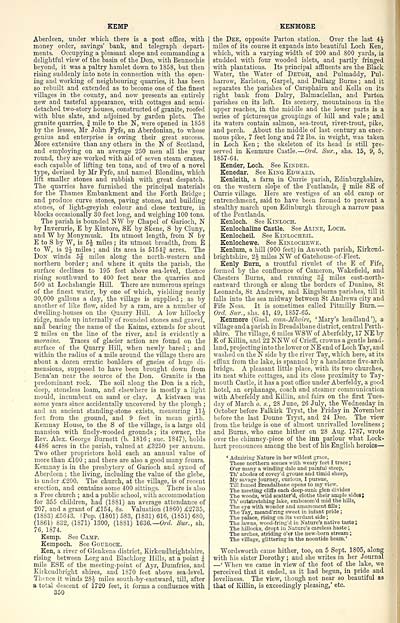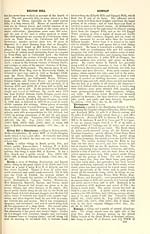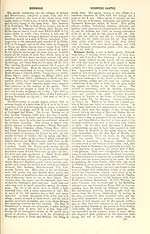Ordnance gazetteer of Scotland > Volume 4
(132) Page 350
Download files
Complete book:
Individual page:
Thumbnail gallery: Grid view | List view

KEMP
KENMORE
Aberdeen, under which there is a post office, with
money order, savings' bank, and telegraph depart-
ments. Occupying a pleasant slope and commanding a
delightful view of the basin of the Don, with Bennochie
beyond, it was a paltry hamlet down to 1858, but then
rising suddenly into note in connection with the open-
ing and working of neighbouring quarries, it has been
so rebuilt and extended as to become one of the finest
villages in the county, and now presents an entirely
new and tasteful appearance, with cottages and semi-
detached two-story houses, constructed of granite, roofed
with blue slate, and adjoined by garden plots. The
granite quarries, | mile to the N, were opened in 1858
by the lessee, Mr John Fyfe, an Aberdonian, to whose
genius and enterprise is owing their great success.
More extensive than any others in the N of Scotland,
and employing on an average 250 men all the year
round, they are worked with aid of seven steam cranes,
each capable of lifting ten tons, and of two of a novel
type, devised by Mr Fyfe, and named Blondins, which
lift smaller stones and rubbish with great despatch.
The quarries have furnished the principal materials
for the Thames Embankment and the Forth Bridge ;
and produce curve stones, paving stones, and building
stones, of light-greyish colour and close texture, in
blocks occasionally 30 feet long, and weighing 100 tons.
The parish is bounded N¥ by Chapel of Garioch, N
by Inverurie, E by Kintore, SE by Skene, S by Cluny,
and W by Monymusk. Its utmost length, from N by
E to S by W, is 5J miles ; its utmost breadth, from E
to W, is 2J miles ; and its area is 5154§ acres. The
Don winds 5§ miles along the north-western and
northern border ; and where it quits the parish, the
surface declines to 195 feet above sea-level, thence
rising southward to 400 feet near the quarries and
500 at Lochshangie Hill. There are numerous springs
of the finest water, by one of which, yielding nearly
30, 000 gallons a clay, the village is supplied ; as by
another of like flow, aided by a ram, are a number of
dwelling-houses on the Quarry Hill. A low hillocky
ridge, made up internally of rounded stones and gravel,
and bearing the name of the Kaims, extends for about
2 miles on the line of the river, and is evidently a
moraine. Traces of glacier action are found on the
surface of the Quarry Hill, when newly bared ; and
within the radius of a mile around the village there are
about a dozen erratic boulders of gneiss of huge di-
mensions, supposed to have been brought down from
Bena'an near the source of the Don. Granite is the
predominant rock. The soil along the Don is a rich,
deep, stoneless loam, and elsewhere is mostly a light
mould, incumbent on sand or clay. A kistvaen was
some years since accidentally uncovered by the plough ;
and an ancient standing-stone exists, measuring 11 J
feet from the ground, and 9 feet in mean girth.
Kemnay House, to the S of the village, is a large old
mansion with finely-wooded grounds ; its owner, the
Kev. Alex. George Burnett (b. 1816 ; sue. 1847), holds
4486 acres in the parish, valued at £3250 per annum.
Two other proprietors hold each an annual value of
more than £100 ; and there are also a good many feuars.
Kemnay is in the presbytery of Garioch and synod of
Aberdeen ; the living, including the value of the glebe,
is under £200. The church, at the village, is of recent
erection, and contains some 400 sittings. There is also
a Free church ; and a public school, with accommodation
for 355 children, had (1881) an average attendance of
207, and a grant of £154, 8s. Valuation (1860) £2735,
(1883) £5643. IPop. (1801) 583, (1831) 616, (1851) 680,
(1861) 832, (1871) 1300, (1881) 1636.— Orel. Sur., sh.
76, 1874.
Kemp. See Camp.
Kempoch. See Goitrock".
Ken, a river of Glenkens district, Kirkcudbrightshire,
rising between Lorg and Blacklorg Hills, at a point j
mile ESE of the meeting-point of Ayr, Dumfries, and
Kirkcudbright shires, and 1870 feet above sea-level.
Thc-nce it winds 28J miles south-by-eastward, till, after
a total descent of 1720 feet, it forms a confluence with
350
the Dee, opposite Parton station. Over the last 4J
miles of its course it expands into beautiful Loch Ken,
which, with a varying width of 200 and 800 yards, is
studded with four wooded islets, and partly fringed
with plantations. Its principal affluents are the Black
"Water, the "Water of Detch, and Pulmaddy, Pul-
harrow, Earlston, Garpel, and Dullarg Burns ; and it
separates the parishes of Carsphairn and Kells on its
right bank from Dairy, Balmaclellan, and Parton
parishes on its left. Its scenery, mountainous in the
upper reaches, in the middle and the lower parts is a
series of picturesque groupings of hill and vale ; and
its waters contain salmon, sea-trout, river-trout, pike,
and perch. About the middle of last century an enor-
mous pike, 7 feet long and 72 lbs. in weight, was taken
in Loch Ken ; the skeleton of its head is still pre-
served in Kenmure Castle. — Orel. Sur., shs. 15, 9, 5,
1857-64.
Kender, Loch. See Kinder.
Kenedar. See King Edward.
Kenleith, a farm in Currie parish, Edinburghshire,
on the western slope of the Pentlands, f mile SE of
Currie village. Here are vestiges of an old camp or
entrenchment, said to have been formed to prevent a
stealthy march upon Edinburgh through a narrow pass
of the Pentlands.
Kenloeh. See Kinloch.
Kenloehaline Castle. See Aline, Loch.
Kenlocheil. See Kinlocheil.
Kenlochewe. See Kinlochewe.
Kenlum, a hill (900 feet) in Anwoth parish, Kirkcud-
brightshire, 2J miles NW of Gatehouse-of-Fleet.
Kenly Burn, a troutful rivulet of the E of Fife,
formed by the confluence of Cameron, Wakefield, and
Chesters Burns, and running 3g miles east-north-
eastward through or along the borders of Dunino, St
Leonards, St Andrews, and Kingsbarns parishes, till it
falls into the sea midway between St Andrews city and
Fife Ness. It is sometimes called Pitmilly Burn. —
Orel. Sur., shs. 41, 49, 1857-65.
Kenmore (Gael. ccan-Mlioire, 'Mary's headland'), a
village and a parish in Breadalbane district, central Perth-
shire. The village, 6 miles WSW of Aberfeldy, 17 NE by
E of Killin, and 22 NNW of Crieff, crowns a gentle head-
land, projecting into the lower or NE end of Loch Tay, and
washed on the N side by the river Tay, which here, at its
efflux from the lake, is spanned by a handsome five-arch
bridge. A pleasant little place, with its two churches,
its neat white cottages, and its close proximity to Tay-
mouth Castle, it has a post office under Aberfeldy, a good
hotel, an orphanage, coach and steamer communication
with Aberfeldy and Killin, and fairs on the first Tues-
day of March o. s., 28 June, 26 July, the Wednesday in
October before Falkirk Tryst, the Friday in November
before the last Doune Tryst, and 24 Dec. The view
from the bridge is one of almost unrivalled loveliness ;
and Burns, who came hither on 28 Aug. 1787, wrote
over the chimney-piece of the inn parlour what Lock-
hart pronounces among the best of his English heroics —
' Admiring Nature in her wildest grace,
These northern scenes with weary feet I trace ;
O'er many a winding dale and painful steep,
Th' abodes of covey'd grouse and timid sheep,
My savage journey, curious, I pursue,
Till famed Breadalbane opens to my view.
The meeting cliffs each deep-sunk glen divides
The woods, wild scatter'd, clothe their ample sides;
Th' outstretching lake, emhosom'd mid the hills.
The eye with wouder and amazement fills ;
The Tay, meand'ring sweet in infant pride ;
The palace, rising on its verdant side ;
The lawns, wood-fring'd in Nature's native taste ;
The hillocks, dropt in Nature's careless haste ;
The arches, striding o'er the new-born stream ;
The village, glittering in the noontide beam.'
Wordsworth came hither, too, on 5 Sept. 1805, along
with his sister Dorothy ; and she writes in her Journal
— ' When we came in view of the foot of the lake, we
perceived that it ended, as it had begun, in pride and
loveliness. The view, though not near so beautiful as
that of Killin, is exceedingly pleasing,' etc.
KENMORE
Aberdeen, under which there is a post office, with
money order, savings' bank, and telegraph depart-
ments. Occupying a pleasant slope and commanding a
delightful view of the basin of the Don, with Bennochie
beyond, it was a paltry hamlet down to 1858, but then
rising suddenly into note in connection with the open-
ing and working of neighbouring quarries, it has been
so rebuilt and extended as to become one of the finest
villages in the county, and now presents an entirely
new and tasteful appearance, with cottages and semi-
detached two-story houses, constructed of granite, roofed
with blue slate, and adjoined by garden plots. The
granite quarries, | mile to the N, were opened in 1858
by the lessee, Mr John Fyfe, an Aberdonian, to whose
genius and enterprise is owing their great success.
More extensive than any others in the N of Scotland,
and employing on an average 250 men all the year
round, they are worked with aid of seven steam cranes,
each capable of lifting ten tons, and of two of a novel
type, devised by Mr Fyfe, and named Blondins, which
lift smaller stones and rubbish with great despatch.
The quarries have furnished the principal materials
for the Thames Embankment and the Forth Bridge ;
and produce curve stones, paving stones, and building
stones, of light-greyish colour and close texture, in
blocks occasionally 30 feet long, and weighing 100 tons.
The parish is bounded N¥ by Chapel of Garioch, N
by Inverurie, E by Kintore, SE by Skene, S by Cluny,
and W by Monymusk. Its utmost length, from N by
E to S by W, is 5J miles ; its utmost breadth, from E
to W, is 2J miles ; and its area is 5154§ acres. The
Don winds 5§ miles along the north-western and
northern border ; and where it quits the parish, the
surface declines to 195 feet above sea-level, thence
rising southward to 400 feet near the quarries and
500 at Lochshangie Hill. There are numerous springs
of the finest water, by one of which, yielding nearly
30, 000 gallons a clay, the village is supplied ; as by
another of like flow, aided by a ram, are a number of
dwelling-houses on the Quarry Hill. A low hillocky
ridge, made up internally of rounded stones and gravel,
and bearing the name of the Kaims, extends for about
2 miles on the line of the river, and is evidently a
moraine. Traces of glacier action are found on the
surface of the Quarry Hill, when newly bared ; and
within the radius of a mile around the village there are
about a dozen erratic boulders of gneiss of huge di-
mensions, supposed to have been brought down from
Bena'an near the source of the Don. Granite is the
predominant rock. The soil along the Don is a rich,
deep, stoneless loam, and elsewhere is mostly a light
mould, incumbent on sand or clay. A kistvaen was
some years since accidentally uncovered by the plough ;
and an ancient standing-stone exists, measuring 11 J
feet from the ground, and 9 feet in mean girth.
Kemnay House, to the S of the village, is a large old
mansion with finely-wooded grounds ; its owner, the
Kev. Alex. George Burnett (b. 1816 ; sue. 1847), holds
4486 acres in the parish, valued at £3250 per annum.
Two other proprietors hold each an annual value of
more than £100 ; and there are also a good many feuars.
Kemnay is in the presbytery of Garioch and synod of
Aberdeen ; the living, including the value of the glebe,
is under £200. The church, at the village, is of recent
erection, and contains some 400 sittings. There is also
a Free church ; and a public school, with accommodation
for 355 children, had (1881) an average attendance of
207, and a grant of £154, 8s. Valuation (1860) £2735,
(1883) £5643. IPop. (1801) 583, (1831) 616, (1851) 680,
(1861) 832, (1871) 1300, (1881) 1636.— Orel. Sur., sh.
76, 1874.
Kemp. See Camp.
Kempoch. See Goitrock".
Ken, a river of Glenkens district, Kirkcudbrightshire,
rising between Lorg and Blacklorg Hills, at a point j
mile ESE of the meeting-point of Ayr, Dumfries, and
Kirkcudbright shires, and 1870 feet above sea-level.
Thc-nce it winds 28J miles south-by-eastward, till, after
a total descent of 1720 feet, it forms a confluence with
350
the Dee, opposite Parton station. Over the last 4J
miles of its course it expands into beautiful Loch Ken,
which, with a varying width of 200 and 800 yards, is
studded with four wooded islets, and partly fringed
with plantations. Its principal affluents are the Black
"Water, the "Water of Detch, and Pulmaddy, Pul-
harrow, Earlston, Garpel, and Dullarg Burns ; and it
separates the parishes of Carsphairn and Kells on its
right bank from Dairy, Balmaclellan, and Parton
parishes on its left. Its scenery, mountainous in the
upper reaches, in the middle and the lower parts is a
series of picturesque groupings of hill and vale ; and
its waters contain salmon, sea-trout, river-trout, pike,
and perch. About the middle of last century an enor-
mous pike, 7 feet long and 72 lbs. in weight, was taken
in Loch Ken ; the skeleton of its head is still pre-
served in Kenmure Castle. — Orel. Sur., shs. 15, 9, 5,
1857-64.
Kender, Loch. See Kinder.
Kenedar. See King Edward.
Kenleith, a farm in Currie parish, Edinburghshire,
on the western slope of the Pentlands, f mile SE of
Currie village. Here are vestiges of an old camp or
entrenchment, said to have been formed to prevent a
stealthy march upon Edinburgh through a narrow pass
of the Pentlands.
Kenloeh. See Kinloch.
Kenloehaline Castle. See Aline, Loch.
Kenlocheil. See Kinlocheil.
Kenlochewe. See Kinlochewe.
Kenlum, a hill (900 feet) in Anwoth parish, Kirkcud-
brightshire, 2J miles NW of Gatehouse-of-Fleet.
Kenly Burn, a troutful rivulet of the E of Fife,
formed by the confluence of Cameron, Wakefield, and
Chesters Burns, and running 3g miles east-north-
eastward through or along the borders of Dunino, St
Leonards, St Andrews, and Kingsbarns parishes, till it
falls into the sea midway between St Andrews city and
Fife Ness. It is sometimes called Pitmilly Burn. —
Orel. Sur., shs. 41, 49, 1857-65.
Kenmore (Gael. ccan-Mlioire, 'Mary's headland'), a
village and a parish in Breadalbane district, central Perth-
shire. The village, 6 miles WSW of Aberfeldy, 17 NE by
E of Killin, and 22 NNW of Crieff, crowns a gentle head-
land, projecting into the lower or NE end of Loch Tay, and
washed on the N side by the river Tay, which here, at its
efflux from the lake, is spanned by a handsome five-arch
bridge. A pleasant little place, with its two churches,
its neat white cottages, and its close proximity to Tay-
mouth Castle, it has a post office under Aberfeldy, a good
hotel, an orphanage, coach and steamer communication
with Aberfeldy and Killin, and fairs on the first Tues-
day of March o. s., 28 June, 26 July, the Wednesday in
October before Falkirk Tryst, the Friday in November
before the last Doune Tryst, and 24 Dec. The view
from the bridge is one of almost unrivalled loveliness ;
and Burns, who came hither on 28 Aug. 1787, wrote
over the chimney-piece of the inn parlour what Lock-
hart pronounces among the best of his English heroics —
' Admiring Nature in her wildest grace,
These northern scenes with weary feet I trace ;
O'er many a winding dale and painful steep,
Th' abodes of covey'd grouse and timid sheep,
My savage journey, curious, I pursue,
Till famed Breadalbane opens to my view.
The meeting cliffs each deep-sunk glen divides
The woods, wild scatter'd, clothe their ample sides;
Th' outstretching lake, emhosom'd mid the hills.
The eye with wouder and amazement fills ;
The Tay, meand'ring sweet in infant pride ;
The palace, rising on its verdant side ;
The lawns, wood-fring'd in Nature's native taste ;
The hillocks, dropt in Nature's careless haste ;
The arches, striding o'er the new-born stream ;
The village, glittering in the noontide beam.'
Wordsworth came hither, too, on 5 Sept. 1805, along
with his sister Dorothy ; and she writes in her Journal
— ' When we came in view of the foot of the lake, we
perceived that it ended, as it had begun, in pride and
loveliness. The view, though not near so beautiful as
that of Killin, is exceedingly pleasing,' etc.
Set display mode to: Large image | Transcription
Images and transcriptions on this page, including medium image downloads, may be used under the Creative Commons Attribution 4.0 International Licence unless otherwise stated. ![]()
| Gazetteers of Scotland, 1803-1901 > Ordnance gazetteer of Scotland > Volume 4 > (132) Page 350 |
|---|
| Permanent URL | https://digital.nls.uk/97381930 |
|---|
| Attribution and copyright: |
|
|---|---|

